
First came the warning of an imminent attack from Iran. Then air raid sirens began to wail in Israel’s capital, Tel Aviv, signalling for residents to scramble into bomb shelters. At 7.30pm, missiles streaked across the night sky – only to collide with Israel’s own counter missiles.
Of the roughly 180 missiles that Iran fired into Israel on Tuesday night – the biggest missile attack it has ever launched on Israel – most were intercepted by Israel’s missile defence system and US naval destroyers in the region. Israel Prime Minister Benjamin Netanyahu called the attack a failure. “It was thwarted thanks to Israel’s air-defence array, which is the most advanced in the world,” he said.
Iran said the barrage was retaliation for Israel’s attacks that have killed the leaders of Hezbollah and Hamas in recent months as well as a leader in the Iranian military. It claimed most of the missiles hit their targets, which were military bases in around Tel Aviv.
Israel’s so-called Iron Dome missile defence system has been protecting its citizens for most of this century. It has intercepted thousands of rockets lobbed by militants from neighbouring areas. After defending against rockets fired by Hezbollah out of Lebanon over the past year, the spotlight has now swung to Iran – which had been vowing to retaliate against Israel since the assassination of Hamas’s leader in a Tehran guesthouse in July. The strike came as Israel launched a “limited” ground operation into Lebanon on its north border against Hezbollah.
The conflict in the Middle East shows no signs of stopping. Netanyahu vowed to retaliate against Iran, saying, “whoever attacks us, we will attack them”. And Hezbollah, one of the most armed non-state actors in the world, continues to pose a threat that could put Israel’s missile defence system to the test.
So, what is the Iron Dome? Could Israel’s adversaries overwhelm it?
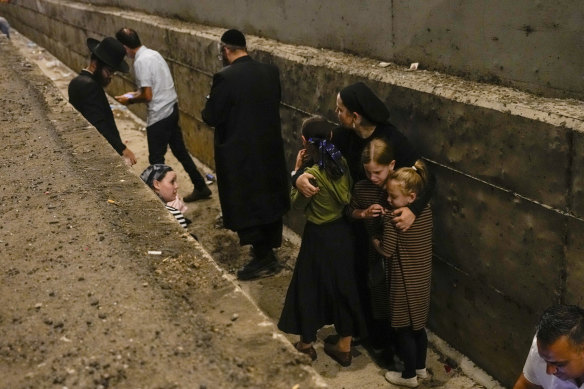
Families take cover from Iranian missiles on a freeway in Shoresh, between Jerusalem and Tel Aviv in Israel on October 1.Credit: AP
What is the Iron Dome?
Israeli efforts to develop a missile shield go back four decades. In 1986, Israel and the United States signed a memorandum of understanding to develop missile defence, tied to US president Ronald Reagan’s Strategic Defense Initiative (known as Star Wars). Efforts were stepped up in 1991 when Iraq fired conventionally armed Scud missiles at Israel during the Gulf War, according to Peter Dombrowski and Catherine McArdle Kelleher in a 2013 analysis. “Since then, Israel and the United States have co-operated on several missile-defense programs, including joint technology development, industrial co-operation, and a program of testing and exercises in addition to shared funding,” they write. “Far more than the United States, Israel sees its adversaries’ air and missile capabilities (including conventionally armed ballistic missiles) as part of a continuous spectrum of threats to its population and forces.”
Israel began work on Iron Dome after its 34-day war with Lebanon in 2006. Its first mobile battery (more on them in a moment) was rolled out in March 2011 on the outskirts of Beersheba, a town in southern Israel, after a bout of rocket attacks by militants in Gaza. In April of that year, the IDF said it had used the Iron Dome to intercept its first missile, a rocket from Gaza targeting the coastal city of Ashkelon. According to the Centre for Strategic and International Studies, the Iron Dome was further developed with assistance from the United States between 2012 and the 2014 Gaza conflict, by which time nine batteries were operational. CSIS reports that during that conflict some 4500 rockets and mortars were launched into Israel; around 800 were identified as a threat to life; 735 were successfully intercepted.
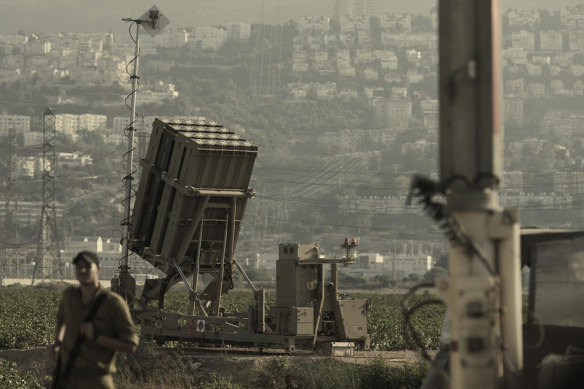
An Iron Dome missile battery in Haifa in 2013.Credit: Getty Images, digitally tinted
In essence, when a short-range missile, rocket or drone hurtles towards Israel, a sophisticated system on the ground works out whether to counter the incoming projectile with its own missile or not. It is designed to ignore those that don’t pose an obvious threat.
Today, the Iron Dome consists of at least 10 sites in Israel that form a shield against the common types of projectiles its neighbours have used to threaten it. Each site is called a “battery” and includes three components: radars; three or four launchers, each holding 20 interceptor missiles; and a manned control centre from where defence personnel oversee interceptions. “What humans do is analyse the attack profile that’s coming in and then, essentially, work out how best to counter it,” says Malcolm Davis, a senior analyst at the Australian Strategic Policy Institute. “And then the Iron Dome System is automated, in the sense that you’re not having humans launching individual missiles.”
The system can down rockets launched from between four and 70 kilometres away (roughly the distance from, say, Lebanon’s south to Haifa, or from Gaza to Tel Aviv.) For shorter-range attacks, the process from radar detection to interception can take less than 30 seconds, says Iain Boyd, director of the Centre for National Security Initiatives at the University of Colorado.
One of the system’s strengths is its mobility. “It’s not a fixed thing,” says Michael Shoebridge, director of Strategic Analysis Australia. “You can relocate the systems and position them if the threat changes. It also means as far as targeting them to destroy them, that’s harder because they can move.”
Israeli company Rafael Advanced Defense Systems says the Iron Dome has a 90 per cent interception rate. “It has proven extremely effective since last year since the Hamas attacks,” says Shoebridge. Still, some rockets fired by Hezbollah across the Blue Line – the de facto border between Lebanon and Israel – have caused destruction, not least one that killed 12 children at a soccer field in the Golan Heights in July.
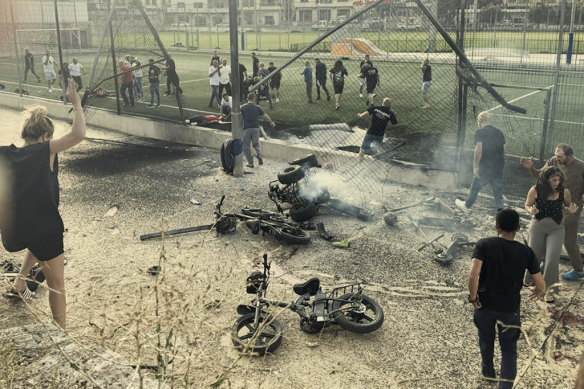
Residents of the town Majdal Shams, in the Golan Heights, rush to help injured children moments after a rocket fired from Lebanon hit a soccer field. Credit: AP, digitally tinted
The Iron Dome is not Israel’s only missile defence system – “it’s the poster child,” says Shoebridge – instead forming part of a layered approach. Israel defends itself against potential long-range ballistic missile attacks with “Arrow 3”, capable of shooting down missiles from as high as space, while “Arrow 2” protects against medium-range missiles fired through the upper atmosphere. The Arrow system uses radar and satellite technology, says Davis. “If they detect an Iranian missile being launched, they would immediately get a notification from the satellite that would then give them a missile tracker.”
Loading
Another layer is David’s Sling, capable of intercepting missiles from 40 to 300 kilometres away. It is designed to spot ballistic missiles, cruise missiles, aircraft and drones. Israel had rarely used the system before the Gaza War – and has used it sparingly since, including to shoot down several Hamas projectiles aimed at Tel Aviv and Jerusalem in 2023. In September, it also intercepted a Qadr 1 ballistic missile launched from Lebanon towards the headquarters of Israeli intelligence agency Mossad in Tel Aviv, a high-value target that Hezbollah deemed “responsible for the assassination of leaders and the explosion of pagers and wireless devices”.
The IDF also has radar-directed cannons and machine guns to deploy against short-range rockets and drones. “They’re like multiple umbrellas,” Shoebridge says of the overall system. “Each umbrella can be porous, and that’s why you need multiple layers.”
Israel’s allies also provide another layer of defence. After Tuesday’s attack, a spokesman for the US Pentagon two US Navy destroyers fired about a dozen interceptor missiles to down Iranian projectiles.
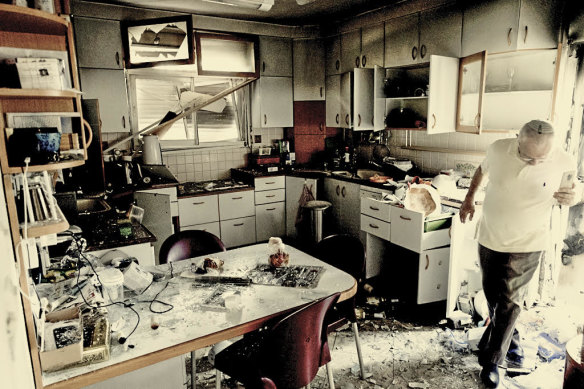
In Moreshet in Israel, a man inspects damage to his kitchen from a rocket fired from Lebanon on September 22. Credit: Getty Images, digitally tinted
Can attacking rockets overwhelm the Iron Dome?
Most of Iran’s missiles have been blocked by Israel’s broad missile-defence system, which also deal with projectiles that are more powerful than just rockets and drones. However, the deadly October 7 attack on Israel showed that the system could be penetrated. Hamas-led militants fired an estimated 3500 projectiles from Gaza on that day, most in a short timeframe, providing cover for the trucks, motorbikes and even a paraglider they used to cross into Israel where they killed nearly 1200 people.
The Iron Dome layer has a saturation point, although this point is not publicly known. For its part, Hezbollah has built up a significant arsenal – the CSIS estimates it had about 200,000 rockets or more in March – but the strength of these weapons is patchy. “Some are ‘homemade’ – and generally ineffective – and some come from Iran and Syria [and are] more reliable,” says Iain Boyd. Many are thought to be unguided: “point and shoot” rockets that might be effective on the battlefield at short range but tend to be wildly inaccurate at longer distances.
Martin Kear, an academic specialising in resistance movements and Middle East politics at the University of Sydney, says it appears Hezbollah does have a large arsenal of long-distance weapons “but we need to make the distinction between rockets and missiles”. “The rockets they have are unguided subsonic weapons that are only a couple of stages advanced from what the Russians used during the Second World War … it’s a quantum leap between those rockets and missiles.”
Iran is estimated to have thousands of ballistic missiles – which travel at high parabolic trajectories – as well as cruise missiles that can travel at a lower altitude. In an earlier attack on Israel in April, it also used more than 100 drones. “If the Iranians can launch sufficiently large attacks with these weapons in a way that overwhelms the Israeli missile defence systems in terms of Arrow, David’s Sling and Iron Dome, potentially co-ordinated with Hezbollah doing the same thing, then you could see significant damage being done to Israel,” Davis says.
Too many rockets approaching is one way a missile defence system can be overwhelmed, or the Israelis could simply run out of interception missiles. Whether the Iron Dome itself could be overcome is partly down to a simple equation, says Boyd: “How many rockets and missiles does Hezbollah have against the number of interceptors that Israel has.” This is one reason for Israel recently ramping up its offensive against Hezbollah. “If you can use one bomb to take out 50 rockets, that’s much more economical than having to lob 50 or 100 Iron Dome missiles,” says Marcus Hellyer, head of research at Strategic Analysis Australia. The Israel Defence Forces says it has struck more than 2000 Hezbollah targets in the past week, including the sites of rockets, missiles and launchers, some of which it claims are hidden under civilian infrastructure. The strikes have led to the deaths of more than 700 people, according to Lebanon health authorities.
Israeli airstrikes also killed Hezbollah’s leader of three decades, Hassan Nasrallah, along with several other senior figures, including the heads of its southern front and special operations forces. These attacks, along with a covert operation to boobytrap and detonate Hezbollah’s pagers and walkie-talkies, have stunned the militant group and diminished their ability to retaliate. “The command and control has been really badly damaged,” Shoebridge says. “So their ability to do highly orchestrated, co-ordinated attacks is probably quite reduced.”
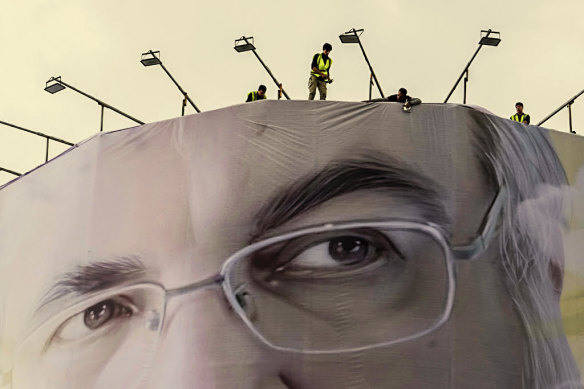
In Iran’s capital, Tehran, workers install a huge portrait of Hezbollah leader Hassan Nasrallah who was killed in an Israeli airstrike in Lebanon on September 27. Credit: AP, digitally tinted
What could happen next?
Netanyahu has vowed to retaliate against Iran. And he insists the attacks against Hezbollah will continue until 60,000 displaced Israelis can return to their homes in northern Israel.
Rodger Shanahan, an Australian Defence Force member who served in Lebanon between 1998 and 2006, says, “the ball is in Israel’s court” regarding what happens next with Iran. “They’ve used the kind of words similar to Iran’s previously that they’ll choose the time and place of the attack,” he says. “So something will happen at some stage.”
Iran had never directly attacked Israel with missiles before April this year, when it launched a smaller barrage of missiles and drones and provided 48 hours notice of the attack. That strike caused no deaths and a limited number of injuries. “Never having done it before, we’ve now seen it twice in six months,” Shanahan says. “That’s part of the thing about deterrence; once you’ve lost it, it’s hard to regain it, even if you do operate within limitations still.”
Loading
Says Shoebridge: “This is a different kind of attack by Iran from the one they did in April. This one is predominantly missiles, and it looks like a lot of ballistic missiles. Iran was probably hoping that the ballistic missiles would be much harder to intercept and they would cause more extensive damage because they’re more powerful, larger weapons. However, it looks like Israel defended successfully against the great majority.
“I think Iran did this because they needed to re-establish their credibility with their terrorist proxies and with the wider Arab world, but I don’t think it’s done that – because Israel’s missile defence system has been so effective.”
Unlike the 1990 Gulf War that had a combat phase of six weeks, Malcolm Davis can’t see a quick resolution. “I think one of the lessons from both Ukraine and the Middle East: we should not assume there is a quick exit from these conflicts.”
Sometimes both sides have to fight a protracted war, he says. “We need to accept the fact that this is the sort of thing that can happen even with all the modern military technology we have.”
This Explainer was first published on September 30 and has since been updated to reflect developments.
Get fascinating insights and explanations on the world’s most perplexing topics. Sign up for our weekly Explainer newsletter.



























